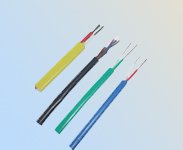
PTFE Thermocouple Cables

The thermocouple cable consist of two wire legs made from dissimilar metals which are fixed together at one end, creating a junction. If the two junctions are held at different temperatures, an electrical potential is produced. When this junction experiences a change in temperature, a voltage is created, this voltage can then be measured and referenced back to the thermocouple wire temperature.
PTFE Thermocouple cables are used for sensing temperatures ranging from low temperature of - 65 degree centigrade to high temperature of 200 degree centigrade. A thermocouple is an electrical circuit with two dissimilar metal wires using copper conductors plated with silver and using a nickel plate copper conductor.
The thermocouple wire types are varies from the two:
K type thermocouple wire -
Nickel-Chromium or Nickel-Aluminium: Most common is the couple called “K”, made with on one side a Nickel/Chromium alloy, called Chromel, and the other side a Nickel/Aluminium alloy, called Alumel. The K type thermocouple wire has a positive leg of Chromel (90% nickel, 10% chromium) and a negative leg of Alumel (95% nickel, 2% aluminum, 2% manganese and 1% silicon). K type thermocouple wire is a common type of thermocouple can be found anywhere, due to be resistant to radiation is used in nuclears plants, its grade wire is -270 to 1260 celcius, the extension grade wire is 0 to 200 celcius.
Type J Thermocouple wire -
Iron–constantan: They have a sensitivity of 55 μV/°C and are the preferred type for general purpose measurements in the temperature range of −40 °C to +750 °C, where the typical measurement inaccuracy is ±0.75%. Type J Thermocouple wire performance is little affected by either oxidizing or reducing atmospheres.
A thermocouple generates voltage when two dissimilar metals have a measuring junction and a reference junction The thermocouple cable connecting the measuring and reference junctions must be made of the same metals used to avoid errors caused by introducing additional thermocouples. A thermocouple wire is a sensor used to measure temperature in a number of processes.
There are three major thermocouple cable uses for this phenomena:
Temperature sensing -
If first junction is held at a reference temperature, a voltage is produced in compensating cables as a result of the temperature difference between the second junction. The proportionality between the temperature and voltage depend on the material used. A commonly used material pair is k type thermocouple wire.
Power production -
With the same setup as above, and several or more thermocouple wire types of series can produce power. The Voyager spacecraft use such an arrangement of compensating cables with a Plutonium ring providing heat source. It provides the power for the spacecraft instrumentation and communications radio.
Cooling/heating -
The same principal can be used in reverse, to provide heating or cooling between two points of thermocouple cable when an electrical current is supplied. The compensation is required because for every wire connection in the thermocouple circuit, typically the compensating cable shows an error voltage, or current, is introduced. This error requires correction.
Thermocouple wire and cable manufacturer - SSI Cables
SSI Cables PTFE thermocouple cables are temperature sensors that are known for their durability, versatility and cost- effectiveness. Therefore our thermocouple wires are generally used in a wide variety of applications, ranging from heavy industrial and process industry usage to environmental and laboratory testing.
More applications include temperature measurement for kilns, gas turbine exhaust, diesel engines, and other industrial processes. Thermocouple cables are also used in homes, offices and businesses as the temperature sensors in thermostats, and also as flame sensors in safety devices for gas-powered appliances.
